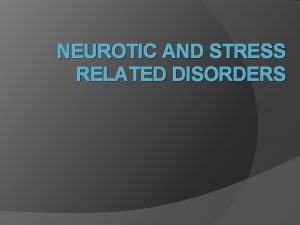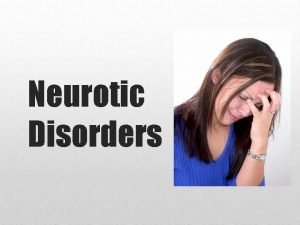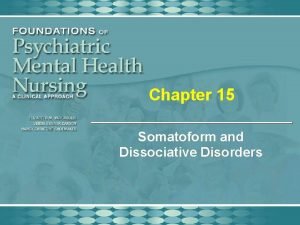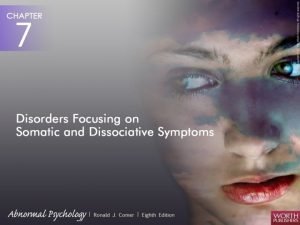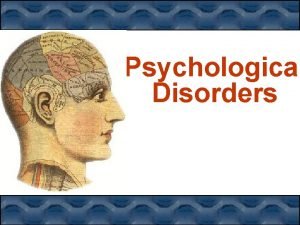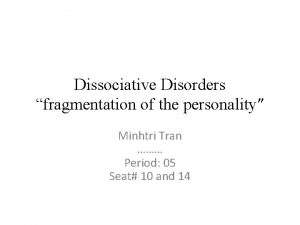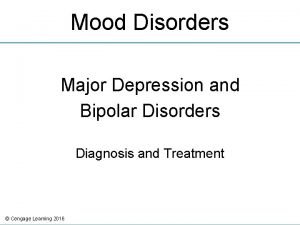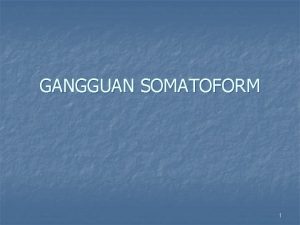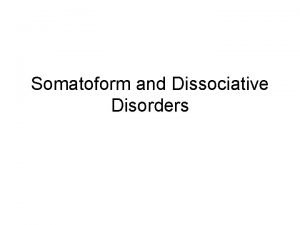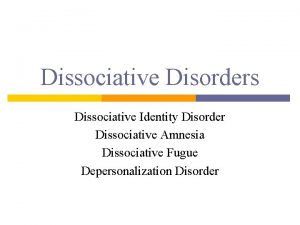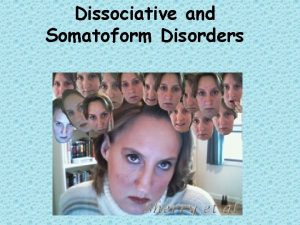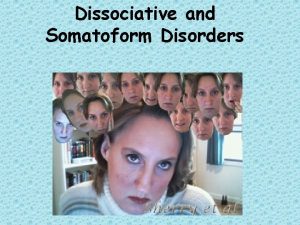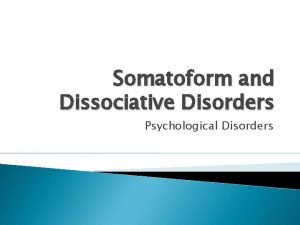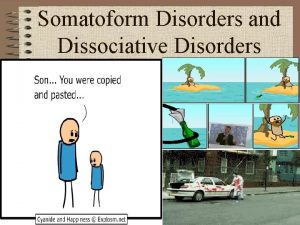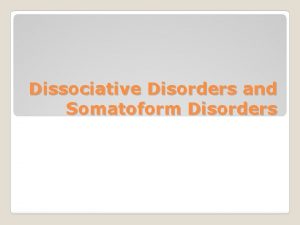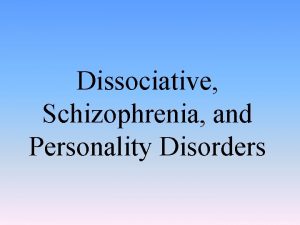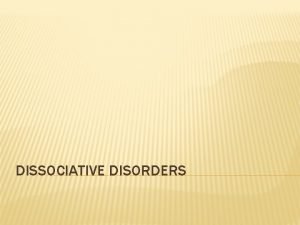Disorders Mood Dissociative and Somatoform Somatoform Disorders Various










- Slides: 10

Disorders: Mood, Dissociative, and Somatoform

Somatoform Disorders Various disorders that have no medical cause • They must happen before age 30 – rules out aches and pains of aging. Conversion Disorder: • A person develops symptoms such as paralysis, numbness or blindness. Yet, there is no medical reason for the symptoms. Hypochondriasis: • Preoccupation or worry about having a serious illness Ex: My headache is a sign I have a brain tumor. Somatization Disorder: • Repeated complaints about vague and unverifiable medical conditions: dizziness, nausea, conscious awareness of an irregular heartbeat (too fast, too slow, etc. )

Dissociative Disorders Dissociation is the feeling that you are outside of yourself, looking at yourself. That your mind is separate from your body. A person’s memories and emotions are somehow separated from his/her conscious awareness. • This is a controversial disorder category; many experts do not believe they are ‘real’ Dissociative Amnesia • Selective memory loss of a specific traumatic event (not a brain injury). The amnesia vanishes as abruptly as it begins and rarely reoccurs. Ex: A woman who gives birth to a stillborn baby might not remember that she was even pregnant.

Continued • Fugue-state • This type of dissociation involves a person who just leaves one’s home and starts on new life, with no memory of one’s past life. The memory may reoccur and the person may return home, only to leave again. • Dissociative Identity Disorder: • This is a disorder wherein your mind partitions itself into two or more distinct personalities that may or may not know about each other. One “personality” emerges to handle stressful situations that the whole psyche or other parts cannot handle. • Caused by traumatic event or events where the mind represses parts of itself that can’t handle the pain. • Repressed from a psychoanalytical point of view.

Mood Disorders • A depressive disorder is an illness that involves the body, mood, and thoughts. • It affects the way a person eats and sleeps, the way one feels about oneself, and the way one thinks about things. • Nearly everyone will experience at least some type of mild depression in their life often due to some external sad event. • A depressive disorder is not the same as a passing blue mood. It is not a sign of personal weakness or a condition that can be willed or wished away. • People with a depressive illness cannot merely "pull themselves together" and get better. Without treatment, symptoms can last for weeks, months, or years. Appropriate treatment, however, can help most people who suffer from depression.

Symptoms of Depression • • • Persistent sad, anxious, or "empty" mood Feelings of hopelessness, pessimism Feelings of guilt, worthlessness, helplessness Loss of interest in hobbies and activities that were once enjoyed Decreased energy, fatigue, being "slowed down” Difficulty concentrating, remembering, making decisions Insomnia, early-morning awakening, or oversleeping Changes in appetite and weight loss or weight gain Thoughts of death or suicide; suicide attempts Restlessness, irritability Persistent physical symptoms that do not respond to treatment, such as headaches, digestive disorders, and chronic pain

Cont. • • Major Depressive Disorder Combination of symptoms that interfere with the ability to work, study, sleep, eat, and enjoy once pleasurable activities. Such a disabling episode of depression may occur only once but more commonly occurs several times in a lifetime. Dysthymia A less severe type of depression, dysthymia, involves long-term, chronic symptoms that do not disable, but keep one from functioning well or from feeling good. Many people with dysthymia also experience major depressive episodes at some time in their lives. Depressed mood for most of the day, for more days than not, as indicated either by subjective account or observation by others, for at least 2 years. Less severe than major depressive disorder. 5 (or more) of the symptoms have been present during the same 2 -week period

Cont. • Bipolar Disorder (previously Manic-Depression/Depressive): • Cycling mood changes: severe highs (mania) and lows (depression) • Mania often affects thinking, judgment, and social behavior in ways that cause serious problems and embarrassment. Mania, left untreated, may worsen to a psychotic state. Symptoms include: • Abnormal or excessive elation, overactive / overtalkative, unusual irritability, decreased need for sleep, grandiose notions, increased talking, racing thoughts, increased sexual desire, markedly increased energy, poor judgment, inappropriate social behavior

Seasonal Affective Disorder (SAD) • regularly occurring symptoms of depression (excessive eating and sleeping, weight gain) during the fall or winter months • full remission from depression occur in the spring and summer months • a craving for sugary and/or starchy foods

